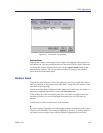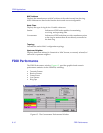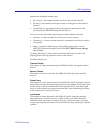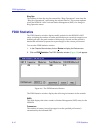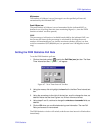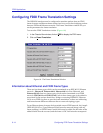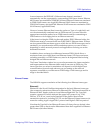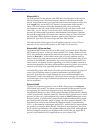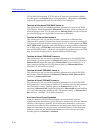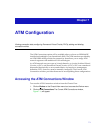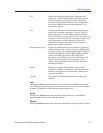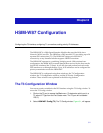
FDDI Applications
6-16 Configuring FDDI Frame Translation Settings
Ethernet 802.2
The Ethernet 802.2 frame format is the IEEE 802.3 formalization of the original
Ethernet frame format. This frame format is similar to the Ethernet II frame
format, except that the two byte Type Þeld is eliminated and replaced with a two
byte Length Þeld, and an 802.2 LLC header is encapsulated within the 802.3
frame. This LLC header contains the destination and source addressing
information for the LLC frame (DSAP and SSAP), and a one byte Control Þeld
(the LSAP Ð or LLC Service Access Point value) which provides the frameÕs
protocol ID. Ethernet 802.2 packets are differentiated from Ethernet II packets
because the Length Þeld will always have a decimal value of 1500 or less (since
the data Þeld in Ethernet frames cannot be greater than 1500 bytes), and the
Ethernet II Type Þeld will always be greater than 1500 decimal.
This is the default frame type for Novell NetWare software version 3.12 and
beyond; it is also used for OSI packets on IEEE 802.x LAN networks.
Ethernet 802.3 (Ethernet Raw)
The Ethernet 802.3 frame format has an 802.3 MAC layer header (as do Ethernet
802.2 frames); however, it does not contain an 802.2 LLC header. Instead, Novell
IPX is Þxed within the packet as the network layer protocol. This frame type Ð also
known as Raw 802.3 Ð is the default frame type for Novell NetWare
software
before version 3.11. Since these frames do not carry the 802.2 header, they do not
conform to the IEEE 802.3 speciÞcation. If you are using the Ethernet 802.3 Raw
frame format, you should consider upgrading your Novell NetWare software to
ensure interoperability with other communications protocols (unless your current
network is not likely to be upgraded, and has no interoperability problems).
Note that IPX packets with checksums which provide data integrity (a feature of
newer Novell NetWare releases) cannot be transmitted on Ethernet 802.3
networks. Note also that a single Ethernet can carry both Ethernet 802.3 and
Ethernet 802.2 trafÞc simultaneously. The Novell server software will treat the
two frame types as two logical networks (and function as an IPX router between
the two networks).
Ethernet SNAP
To allow for proprietary protocols, such as IBMÕs SNA protocol, the Ethernet
SNAP frame was created. This frame format extended the Ethernet 802.2 packet
by improving the frameÕs byte alignment, and by allowing further protocol
identiÞcation than the one byte LSAP protocol identiÞer of Ethernet 802.2 frames
(which is reserved for standard protocols). Ethernet SNAP packets have an LSAP
protocol ID of hex AA, indicating that they contain a SNAP (Subnetwork Access
Protocol) packet. A SNAP packet, encapsulated within the Ethernet 802.2 packet,
has a Þve byte SNAP header which is simply a Þve byte protocol identiÞer. The
Þrst three bytes of the header indicate the Organizationally Unique IdentiÞer
(OUI) Ð or the authority assigning the protocol ID Ð and the last two bytes indicate
the protocol according to that authority. Note that for most protocols, the OUI is
0-0-0, and the type identiÞer is the standard Ethernet protocol ID. Although most
Ethernet transport protocols use the Ethernet II frame format, the AppleTalk II
protocol uses Ethernet SNAP (AppleTalk has its own unique OUI).




